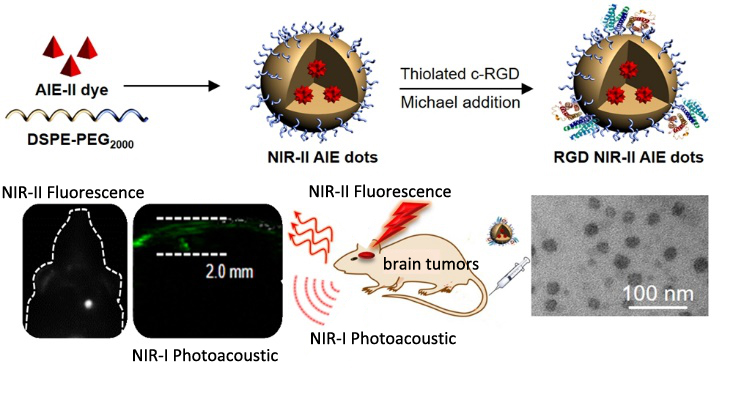New NIR-II Fluorescent Molecule With Aggregation-Induced-Emission Used for Orthotopic Brain-tumor Imaging
Date:05-06-2018 | 【Print】 【close】
Nowadays, brain tumors inside the complex central nervous system remains one of the most challenging cancers to diagnose.
This urges the emergence of novel brain-imaging modalities and the corresponding contrast agents, which work together to offer outcomes with good sensitivity and specificity, deep penetration, high spatial and temporal resolution.
Different from conventional brain-imaging techniques like positron emission tomography (PET), computed tomography (CT), ultrasound imaging (US), single-photon emission computed tomography (SPET), and magnetic resonance imaging (MRI), nearinfrared (NIR) fluorescence imaging demonstrates particular merits including being nonhazardous, fast feedback, and higher sensitivity.
Fluorescence imaging in the second NIR window (NIR‐II) (1000–1700 nm) exhibits salient advantages of deeper penetration and higher spatiotemporal resolution, owing to further reduced photon scattering, absorption, and tissue autofluorescence in biological tissues.
The research team led by Prof. ZHENG Hairong, collaborated with Prof. LIU Bin, from University of Singapore, reported the first NIR‐II fluorescent molecule with aggregation-induced-emission (AIE) characteristics for dual fluorescence and photoacoustic imaging, was published in Advanced Materials.
In this study, they designed a new donor–acceptor (D–A) tailored NIR-II emissive AIE molecule, formulated dots show a high NIR‐II fluorescence quantum yield up to 6.2%, owing to the intrinsic aggregation‐induced emission nature of the designed molecule. The AIE dots have been successfully used for dual NIR‐II fluorescence and NIR‐I photoacoustic imaging for precise noninvasive brain‐tumor diagnosis. Based on the same dots, the experiments revealed that NIR‐II fluorescence imaging showed a high resolution of 38 μm over cerebrovascular structure with a detection limit down to 3.9 μg mL-1. Meanwhile, NIR‐I PA imaging intrinsically exhibits higher penetration depth than that of NIR‐II fluorescence imaging, which allowed clear delineation of tumor depth in the brain. The synergetic bimodal imaging with targeting c‐RGD‐decorated bright AIE nanoparticles showed precise brain‐tumor diagnosis with good specificity and high sensitivity, which yielded a high S/B of 4.4 and accurately assessed the depth of tumor location inside brain tissues.

This research demonstrates the promise of NIR-II AIE molecules and their dots in dual NIR-II fluorescence and NIR-I photoacoustic imaging for precise brain cancer diagnostics.
The research was supported by National Basic Research Program of China (973 Program), National Natural Science Foundation of China (NSFC), Guangdong Province Magnetic Resonance Imaging and Multimode Systems Key Laboratory.
CONTACT:
ZHANG Xiaomin
Email: xm.zhang@siat.ac.cn
Tel: 86-755-86585299